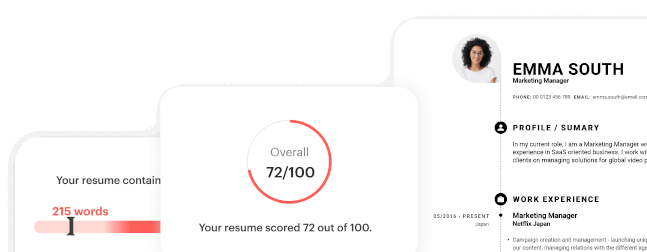Winning a job as a scientist requires you to write an excellent resume that puts a spotlight on your experience and specializations. And that's where our guide steps in — with its practical tips, real-life examples, and easily customizable templates. It's all geared to help you create a resume that effectively showcases your scientific skills and expertise.
In this guide, we cover a few simple steps for writing an excellent resume as a scientist. Continue reading to learn how to:
- Create a well-formatted science resume
- Write an effective resume summary as a scientist
- Select your top skills as a scientist to include in your resume
- Describe your work experience as a scientist with relevant details
- List your educational credentials as a scientist on your resume
- Access the best job search resources for inspiring scientists
1. Choose the best format for your science resume
The very first step to take when writing a science resume is to choose which format you want to use.
There are three formats to select from:
- Reverse-chronological (RC): An RC resume focuses primarily on work experience and is well-suited for job applicants with at least a few different jobs in the industry or 5+ years in one job.
- Functional: A functional resume focuses less on work experience and more on education, skills, and unpaid experience (such as internships or volunteering). This can be a great option for recent graduates who have a lot of academic experience but limited work experience.
- Hybrid: A hybrid resume spreads the focus out amongst all sections of a resume, allowing for a more balanced format overall. This is a good option for applicants who are returning to the workforce after a prolonged break or those who are changing career paths.
Whichever format you ultimately choose, all will require a good-looking header that features your name, professional title, and contact information.
Here is an example of a well-formated science resume header
Jack King, Lab Scientist
(123) 456-7890 | jackking@email.com | linked.com/in/jack-king
2. Write an effective resume summary as a scientist
After choosing which format you would prefer, you can then write your resume summary.
When crafting a resume summary for a science resume, it's essential to capture your key qualifications, experiences, and career goals in a concise and compelling manner.
Start by highlighting your educational background, specifying your degree(s) and any relevant coursework or research projects. Next, emphasize your scientific expertise, such as your laboratory techniques, data analysis skills, and familiarity with specialized equipment or software.
Additionally, showcase your research experience, including any notable findings, publications, or presentations.
Finally, emphasize your career goals and how your scientific background aligns with the specific role or industry you are targeting.
Focus on showcasing your passion for scientific inquiry, your ability to solve complex problems, and your dedication to advancing knowledge and innovation. By effectively summarizing your scientific qualifications and demonstrating your enthusiasm for the field, you'll grab the attention of potential employers and set yourself apart from other candidates in the competitive science industry.
Here is an example of a well-written science resume summary
Results-driven scientist with 7+ years of specialized experience in molecular biology and a passion for advancing healthcare through innovative research. Holds a Ph.D. in Biomedical Sciences with expertise in genetic analysis, cellular imaging, and data interpretation. Experienced in designing and executing complex experiments, analyzing large datasets, and presenting findings at national conferences. Seeking a challenging role in a biotechnology company where I can apply my scientific expertise to drive breakthrough discoveries and contribute to the development of novel therapeutics.
3. Select your top skills as a scientist to include in your resume
With your header and summary in place, your next key step is to consider which of your scientific skills to include on your resume.
You should always include an assortment of both technical and interpersonal skills, as this shows employers you know the crucial importance of both in a professional setting. Technical skills can typically be listed in a side section, while interpersonal skills make good descriptors to use in a work experience section.
Here are 5 examples of technical science skills to include in a resume
- Laboratory protocols and safety practices
- Conducting experiments
- Gathering and analyzing research samples
- Writing and publishing research papers
- Demonstrating lab procedures
Here are 5 examples of interpersonal science skills to include in a resume
- Clear verbal and written communication
- Collaboration
- Leadership
- Active listening
- Problem-solving
4. Describe your work experience as a scientist with relevant details
Now that you have a strong list of skills to sprinkle throughout your science resume, you can begin writing your work experience section.
To keep this section organized, always use bullet points to separate your various descriptions included with each work experience entry. Additionally, try to include only the most relevant, specific, and quantifiable details when possible regarding your experience.
Here is an example of a good work experience entry from a scientist’s resume
Scientist at Golden Labs, Inc.
Mesa, NM
April 2017 to May 2022
- Collaborated with a large laboratory team, assisting with more than 50 total experiments
- Published more than 100 research papers, with features in journals such as Nature, The Lancet, and National Geographic.
- Improved lab organizational systems, resulting in a 15% increase in efficiency when setting up new lab experiments.
5. List your educational credentials as a scientist on your resume
You have made it to the end of this resume guide — the only step that remains is to describe your educational history and credentials.
Unless you are writing a resume in a functional format, your education section can be fairly short and sweet. The most important information to ensure you include is your highest level of education, what institution you attended, and when you graduated.
Here is an example of a well-crafted education section on a scientist’s resume
M.S. in Biology
Harvard University
Cambridge, MA
- Graduated: May 2018
B.S. in Natural Science
Boston University
Boston, MA
6. Best job search resources for aspiring scientists
Navigating the job market as an aspiring scientist can be daunting, but there are numerous resources at your disposal. From job boards that specialize in scientific professions to career development platforms, here are some top resources:
- Job boards: Websites like Science Careers, New Scientist Jobs, and Nature Careers list career opportunities ranging from internships to full-time jobs across various scientific disciplines.
- Networking platforms: LinkedIn is a powerful platform for expanding your professional network, discovering job opportunities, and exchanging ideas with like-minded professionals.
- Professional associations: Association memberships can provide access to exclusive job listings, career advice, conferences, and networking events. Consider organizations like the American Association for the Advancement of Science (AAAS), National Association of Science Writers (NASW), or societies specific to your field of interest.
- Science career blogs/podcasts: For advice and inspiration on pursuing a career in science, explore blogs and podcasts like "Hello PhD" and "Breaking Bio."
- Career development centers: Many universities have career development centers that offer services like resume review, interview training, and job search strategies. They might even have connections with local companies and research institutions that could provide internship or job opportunities.
Keep in mind, finding the perfect scientist job is all about using different ways to look, being patient, and not afraid to change your plan if needed. Every job fair, online job ad, networking event, or chat with someone in the field gets you a bit closer to landing your dream scientist job.
Science Resume FAQ
In your science resume, focus on your education, skills, research experience, publications if applicable, and any relevant work history. Be sure to also include any specific techniques or laboratory skills.
Use a clear and easy-to-read format for your science resume. Typically, you should start with your contact information, followed by a concise summary, then list your education, skills, and experience. Use bullet points to make it easier to scan.
Absolutely! Publications highlight your expertise and commitment to the scientific field. List them in a separate section and use a standard citation format.
In addition to your technical and laboratory skills, don't forget to highlight your problem-solving, analytical thinking, and communication skills. These soft skills are equally important in the scientific field.
If your professional experience is limited, place greater emphasis on your education, lab skills, and any relevant projects or coursework. Remember, it's all about showing potential employers your knowledge, abilities, and potential.


















![Becario de investigación verano en la Universidad currículum [ES]](https://d1xn1bcogdo8ve.cloudfront.net/471/thumbnail.png)


























![How to Write a Professional Resume Summary? [+Examples]](https://d2xe0iugdha6pz.cloudfront.net/article-small-images/i-Profile.svg)
![How to Put Your Education on a Resume? [+Examples]](https://d2xe0iugdha6pz.cloudfront.net/article-small-images/i-Collage-Universities.svg)
![How to Describe Your Work Experience on a Resume? [+Examples]](https://d2xe0iugdha6pz.cloudfront.net/article-small-images/Experience.svg)


